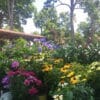
Professor Kinsaku Nakane at the Adachi Museum garden he designed.
If we’re lucky, each one of us will enjoy the influence of a sensei –an accomplished master or respected teacher–in our lives. When I first met my sensei in 1975, Kinsaku Nakane was an up-and-coming garden master in Kyoto, Japan. A young and vital 65 year-old landscape architect and professor at Osaka University of the Arts, Sensei took me under his wing and enabled me to indulge a dream: to immerse myself in the art and design of Japanese gardens.
As a Henry Luce Scholar, I received financial support for a year of study in Japan, along with two months of summer school training to learn Japanese prior to the trip. (I learned just enough to greet Sensei at the train station, but not much else.) After I arrived in Japan, thanks to daily language lessons and a rented room at a Zen Buddhist nunnery, I eventually became proficient enough in Japanese to join the construction and maintenance crew onsite…but that’s another story.
The first thing Sensei asked me to do was to take a few months to go visit as many gardens as I could possibly see. This was not a hardship! Together with another American student, we visited two to three gardens a day, sketching what we saw and photographing when we could. Despite Sensei’s admonition to “open our hearts to their beauty and meaning,” we couldn’t stop from analyzing the aesthetic relationships and compositional techniques we observed.
Sensei brought me along whenever he was setting stones at a job site. He’d stand me behind him as he would guide a stone into place. Immaculately clad in an elegant business suit, handsome fedora, gold watch, and work boots, he’d conduct the work activities like a symphony orchestra, cuing a crane here, a workman there; turning the rock so that its “face” was properly angled to the viewer and it was positioned to look as though it had always been there. When finished, he’d turn to me and say, “Now do you understand?” After setting stones myself over the last thirty years, I believe I can now truthfully answer, “Yes!”
Without the luxury of time to spend looking closely at these remarkable places of beauty and meaning, my life’s work would have turned out completely differently. Both intense and leisurely, this time spent exploring the beauty and meaning of Japanese gardens was pivotal to the direction of my career. For in what other culture could one visit over eighty gardens, each a different composition so perfectly maintained?






Join the discussion One Comment